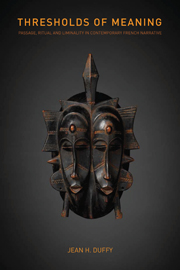Book contents
- Frontmatter
- Contents
- Acknowledgements
- List of illustrations
- Introduction
- 1 At death's door: illness, ritual and liminality in Darrieussecq, Lenoir, and Mauvignier
- 2 Suicide and saving face in Bon, Mauvignier and Bergounioux
- 3 Commemoration, monument and identity in Bergounioux, Darrieussecq and Rouaud
- 4 Retouching the past: family photographs and documents in Rouaud, Bon and Lenoir
- Conclusion: Writing passage and the passage to writing
- Notes
- Select bibliography
- Index
1 - At death's door: illness, ritual and liminality in Darrieussecq, Lenoir, and Mauvignier
- Frontmatter
- Contents
- Acknowledgements
- List of illustrations
- Introduction
- 1 At death's door: illness, ritual and liminality in Darrieussecq, Lenoir, and Mauvignier
- 2 Suicide and saving face in Bon, Mauvignier and Bergounioux
- 3 Commemoration, monument and identity in Bergounioux, Darrieussecq and Rouaud
- 4 Retouching the past: family photographs and documents in Rouaud, Bon and Lenoir
- Conclusion: Writing passage and the passage to writing
- Notes
- Select bibliography
- Index
Summary
In recent years the concepts of rite of passage and, in particular, of liminality have figured prominently in medical and medical-related research, providing useful ways of analysing a range of experiences of illness and disability. With the expansion of the medical humanities and the development of ‘narrative medicine’, medical practitioners have looked to other disciplines – literary analysis, philosophy, history and anthropology – for models and metaphors by which to express the experiences of patients, carers and clinicians. The attraction of the notion of rite of passage is obvious, offering a versatile means of expressing a range of phenomena including: the patient's passage from health to illness and from illness to health and the ways in which he/she endeavours to give structure and meaning to that process; the impact of illness on the carer's life-trajectory; the initiation of the practitioner into the techniques of healing. Since the publication of Ronald Frankenberg's seminal work on illness narrative (1986), health-care researchers have explored the potential applications of the concept of liminality to the analysis of numerous medical and psychiatric conditions. Though the emphasis varies according to the condition examined, most commentators highlight the usefulness of van Gennep's and Turner's definitions of liminality in the description of the life-course disruption that serious illness or injury imposes on the patient and his/her family/carer. Some commentators also point out the potentialities for positive change that may accompany a drastic physical or psychological event and that may be opened up during therapy, sometimes through the performance of or subjection to new quasi-ritualised activities.
- Type
- Chapter
- Information
- Thresholds of MeaningPassage, Ritual and Liminality in Contemporary French Narrative, pp. 29 - 71Publisher: Liverpool University PressPrint publication year: 2011



